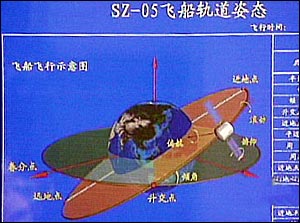When China's first man in space Yang Liwei returned to Earth in a re-entry module exactly six months ago, an orbital vessel was left behind to further gather data.
The orbital module -- the remaining part of the Shenzhou V spacecraft -- is set to descend towards Earth but will likely be reduced to ashes as it penetrates the atmosphere, ground controllers explained to China Daily.
"Shenzhou V's orbital module has reached its designed life of six months," said Liu Junze, a division director of the Beijing Aerospace Command and Control Center.
"Drawn by the Earth's gravity, it will spiral down and will end up falling somewhere in the ocean -- if there are still some small solid pieces left," Liu told China Daily.
Situated in a northwestern suburb of Beijing, Liu's center is the hub of China's space program. It has controlled the launch and recovery of five space capsules between November 1999 and last October.
The module launched with Yang's mission has completed all the scientific experiments it was designed for and has undertaken research rivaling any other space program in the world, noted a statement from the center.
Shenzhou V's orbital module separated from its re-entry module -- which carried Yang -- on October 16. Yang rode Shenzhou V into orbit on October 15 and returned a day later after 21 1/2 hours in space.
Since then, the Beijing Aerospace Command Center has monitored the orbital module daily and has sent more than 2,000 tele-commands to ensure its safety and sound operation, said Liu.
The center stopped tracking and controlling the orbital module on Thursday, after it had flown nearly 2,700 times around the Earth.
Lessons in design
A follow-up to Yang's mission, scheduled for next year, is also designed to include an orbital module, Liu said.
Wang Yongzhi, chief designer of China's space program, said the design of an orbital module is one of the remarkable features that differentiates Chinese spacecraft from those in other space programs run by Russia and the United States.
After the re-entry module from China's spacecraft returns to earth, the remaining part of the craft -- the orbital module -- can continue working in space as an independent satellite carrying out tasks like observation work. This has not been done in other countries, Wang said.
Positioning an unmanned orbital module in space will lay the groundwork for longer stays in space in the future -- not only in a re-entry capsule, but also in a space lab or a space station, Liu said.
During its run in space, experiments conducted on the orbital module helped scientists improve the overall design of spacecraft by sorting out the most suitable equipment and materials to be used and carried on future spacecraft, he said.
The Chinese Academy of Sciences led the experiments on space environment monitoring, space positioning and earth observation.
By monitoring space environments, the orbital module enabled scientists to study the electromagnetic field, particle activity and various rays around the orbit where future space missions will be staged, Liu said.
"Such knowledge is important for us to develop expertise and measures to guarantee the safety of both astronauts and spacecraft," he said.
In addition, the orbital module helped train ground controllers by improving their ability to track and control a spacecraft and command it to maneuver.
Experts at the Beijing Aerospace Command and Control Center are now able to pinpoint the exact location of a Chinese spacecraft at any time. They have also independently developed technology to guide spacecraft to travel to its destination accurately, according to sources at the space center.

China's manned space program aims to establish a space laboratory and, eventually, a space station after breakthroughs in manned space missions and space docking are made, according to a government document the State Council Information Office released in November 2000.
It did not specify a timetable.
Orbital modules will help scientists master space docking and will cut both time and cost on developing the expertise, explained Wang.
To undertake space docking, scientists usually have to launch two spacecraft several days apart. But with an orbital module, which remains in orbit for six months, scientists have more choice as to when to send the docking spacecraft, Wang said.
China's second manned space flight is being planned but it is not clear how many astronauts will be on board. Leading space officials have said, however, that Shenzhou VI is capable of taking more than one person to circle the earth for up to seven days.
(China Daily April 17, 2004)

